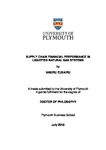SUPPLY CHAIN FINANCIAL PERFORMANCE IN LIQUEFIED NATURAL GAS SYSTEMS
| dc.contributor.supervisor | Dinwoodie, John | |
| dc.contributor.author | Zubairu, Nasiru | |
| dc.contributor.other | Plymouth Business School | en_US |
| dc.date.accessioned | 2019-07-31T10:40:04Z | |
| dc.date.issued | 2019 | |
| dc.identifier | 10506845 | en_US |
| dc.identifier.uri | http://hdl.handle.net/10026.1/14726 | |
| dc.description | Part of the study phase two has been presented and published at Logistics Research Network Conference (LRN 2018), University of Plymouth 5-7 September 2018. | en_US |
| dc.description.abstract |
Liquefied natural gas (LNG) is a rapidly growing energy source, with highly competitive supply chain networks, sensitive to global macro-economic developments. To date, supply chain finance studies have failed to explore supply chain financial performance (SCFP) in the LNG sector and few have demonstrated the potential impact of supply chain practices on financial performance. This study aims to evaluate the relationship between supply chain strategies and the financial performance of Nigeria liquefied natural gas (NLNG) systems, to guide practitioners to review and adopt supply chain initiatives that drive business survival and growth, while creating value for investors. To identify key supply chain strategies that have financial influences for NLNG networks, SCFP related publications between 1999 and 2018 alongside interviews with experts and key decision-makers at NLNG were analysed using template analysis. To prioritise the relative influence of the major supply chain initiatives that drive financial performance in NLNG systems, supplementary data collected from NLNG was analysed using analytical hierarchy process (AHP). In study phase one, qualitative template analysis of literature identified sourcing strategy, information technology and automation, integration and collaboration, and sustainability as key drivers of SCFP in NLNG systems. These drivers are measured using cost, revenue, working capital and assets utilisation. In study phase two, AHP presented integration and collaboration as the most important drivers of financial performance in NLNG networks, followed by sourcing, IT and automation, and sustainability. Study phase three identified investment and capacity development in addition to the four supply chain capabilities established earlier. Effective implementation of these initiatives is essential to realise the full financial advantages of effective supply chain strategies. Theoretical and empirical taxonomies and frameworks facilitate understanding of how supply chain initiatives contribute positively to NLNG financial performance, and support practitioners in making strategic supply chain decisions. The AHP model provides a novel ranking for supply chain strategies and measures to guide decision-makers. | en_US |
| dc.description.sponsorship | Petroleum Technology Development Fund (PTDF), Nigeria | en_US |
| dc.language.iso | en | |
| dc.publisher | University of Plymouth | |
| dc.rights | CC0 1.0 Universal | * |
| dc.rights.uri | http://creativecommons.org/publicdomain/zero/1.0/ | * |
| dc.subject | Liquefied natural gas systems | en_US |
| dc.subject | Supply chain strategies | en_US |
| dc.subject | Supply chain financial performance | en_US |
| dc.subject | Template analysis | en_US |
| dc.subject | Analytical hierarchy process | en_US |
| dc.subject | Systematic literature review | en_US |
| dc.subject | Energy strategies and policies | en_US |
| dc.subject.classification | PhD | en_US |
| dc.title | SUPPLY CHAIN FINANCIAL PERFORMANCE IN LIQUEFIED NATURAL GAS SYSTEMS | en_US |
| dc.type | Thesis | |
| plymouth.version | publishable | en_US |
| dc.identifier.doi | http://dx.doi.org/10.24382/723 | |
| dc.identifier.doi | http://dx.doi.org/10.24382/723 | |
| dc.rights.embargodate | 2020-01-31T10:40:04Z | |
| dc.rights.embargoperiod | 6 months | en_US |
| dc.type.qualification | Doctorate | en_US |
| rioxxterms.version | NA | |
| plymouth.orcid.id | https://orcid.org/0000-0003-0142-4211 | en_US |
Files in this item
This item appears in the following Collection(s)
-
01 Research Theses Main Collection
Research Theses Main



